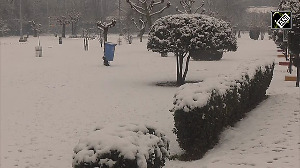Neeraj claims the first three months in China were torture. "I could not understand a word. I thought I made a mistake by coming here," he says passing around cups of Indian tea in his office-cum-guest house.
Neeraj is a textiles trader based in the bustling city of Shaoxing. The apartment is packed with fabric samples on hangers. "And then," he says, "It began making sense." Evidently, as he asks the cook to include dal in the menu for lunch, in fluent Chinese.
Neeraj is one of some 1,200 Indians living and working in Shaoxing, located three hours south of Shanghai and on the southern wing of the Yangtze delta. Shaoxing is popularly known as the textiles capital of China and even Asia. What is perhaps not popularly known is the fact that it has the highest concentration of Indians for any city or town in China, more than Beijing and Shanghai combined.
Like Neeraj, most of the Indians here are textile traders. And yet, very few actually have come from India. Instead, in a fascinating tale of economic migration, they have been drawn over the last five years from Dubai, Hong Kong, Taiwan and even South Korea. Following the manufacturing trail, so to speak. And the Chinese miracle of scale and costs.
Sitting in Shaoxing, Neeraj and his associates source and supply mostly wholesale fabric to markets the world over, including West Asia, Africa, Iran, Iraq and East Europe. India for them is one of many markets.
And they seem to be working all the time.
Precise figures are hard to come by. But five years ago, the Indian trading community used to export around 200 containers every month, half to India.
Today, the community exports more than 3,000 containers a month. At an average of $30,000 a container, it is close to $1 billion worth of business.
The margins are wafer thin, though. The Indian traders' share of exports to India has been rising as well, to around 700 to 800 containers a month today.
Most of Shaoxing's Indian traders started small. Neeraj hails from Byas, Punjab. In 1992, after securing a ITI diploma in air-conditioning and refrigeration, he left for Dubai. "I was the first passport holder in the family," he says.
In Dubai, he worked for a textile company (his diploma did not take him far) and did mostly odd jobs, including sweeping at the end of the day. And then he began learning the trade.
Along the way, he set up his own trading firm, sourcing fabric from Taiwan and South Korea, and supplying it to West Asia. Till manufacturing began moving to China. "We had to come here," he says, referring to his three brothers -- his parents are Radhaswamy Satsang disciples and wish no connection with their sons' textiles business.
The dapper Radhu Phulwani began in Dubai, too, but a good decade earlier. He was the third Indian to settle in Shaoxing, in 1999.
"In Dubai, our overheads were increasing and business decreasing," he says. Phulwani came to China first in 1987 and recalls visiting the country some 50 times before finally settling down. "I saw the decline of the Japanese, the Korean and the Taiwanese textiles markets and the rise of China."
Phulwani says, in the beginning, he would export around 50 containers a month. Today, he does almost 100. Of these, around 10 head for India.
Phulwani also tried setting up base back home. "The bureaucracy was too much," he says. He has an office in Mumbai, but he only visits it. A younger brother from Dubai is here more often. So, like many others, he is trying to make himself feel at home here, in Shaoxing.
That's getting easier. There are four Indian restaurants and two grocery shops, started by the members of the traders' community, probably wanting to diversify. And there is a Shaoxing Indian Business Association as well.
Phulwani happens to be the president of this association. He points out that associations are not permitted in China, particularly ones with religious affiliations. This one exists "unofficially" with official knowledge, he says.
What does the future portend for the Indian trading community ? Will they migrate again ? Neeraj is not so sure. "There are six or seven people in the chain now. It has to come down. While business relationships will matter, it will not be easy," he admits.
He wants to set up shop in Delhi, maybe trade in other commodities as well. He asks this correspondent's companion, an Indian fabric importer, for some advice. "We are already exporting some copper," he says.
Phulwani is more optimistic. "As long as the textiles business does well, I am here. Ten years, 15 years, lets see. China is growing," he says.
Moreover, he says, there are no hassles of doing business here. "They treat us well, they respect us, there is no corruption." When he is not working, he is keeping himself busy with the association. "We have a lot of get-togethers for festivals. But these are social gatherings, not religious," he insists.







 © 2025 Rediff.com -
© 2025 Rediff.com -